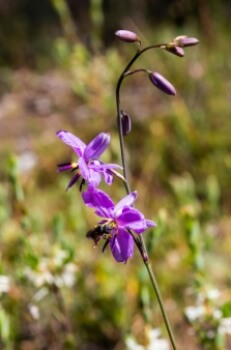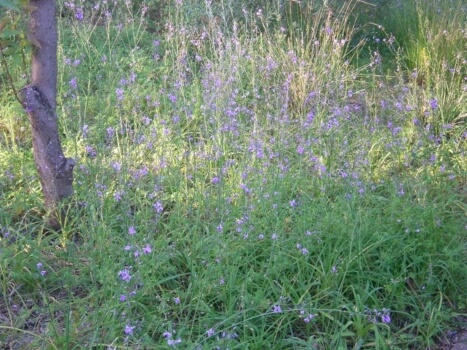We are home to some truly spectacular bush tuckers and one that I deeply admire is the terrifically tuberous Chocolate Lily. Its name alludes to the wonderful scent the beautiful blooms produce which resembles chocolate with notes of caramel and vanilla. Who wouldn’t be interested in this plant already, right?
It is a valued bush tucker for its juicy and nutritious tubers as well as its edible fragrant flowers. Today, I will be discussing how you can grow and care for this native flowering plant and also explain how you can take advantage of its tucker potential in the kitchen.
More...

Family: | Asparagaceae |
|---|---|
Genus: | Dichopogon |
Species: | D. strictus |
Origin: | Australian Native |
Common Names: | Chocolate Lily, Nodding Chocolate Lily |
Location: | Outdoor |
Type: | Flowering plant |
Growth: | Up to 0.5 metres tall, up to 0.3 metres wide |
Sun requirements: | Full sun to part shade |
Foliage Colour: | Green |
Flower Colour: | Mauve |
Flowering: | Summer |
Edible Parts: | Produces edible tubers |
Maintenance level: | Low |
Poisonous for pets: | Toxic to cats and dogs |
Introducing the Chocolate Lily
Its striking blue to violet star-shaped blooms are borne on tall and branched stems where they sit delicately drooping. In addition, the plant features attractive lanceolate leaves, gorgeous evergreen grass-like foliage and a useful clumping habit, perfect for many useful applications within gardens.
Enjoy gorgeous pops of colour in your outdoor spaces with this highly ornamental native.

Source: One Bend In The River
Dichopogon strictus Plant Details
Part of the Asparagaceae family and botanically labelled Dichopogon strictus, the chocolate lily was formerly known as Arthropodium strictum. It is also sometimes referred to as the nodding chocolate lily because of its gently drooping blooms.
It is an Australian native that occurs in the grassland, woodland and forest regions of New South Wales, South Australia, Western Australia, Victoria and Tasmania. It has successfully adapted to most of our endemic conditions so it’s a great pick for almost any garden, regardless of size and climate.
Considered to have a moderate growth rate, this plant will usually grow up to 0.5 metres tall and up to 0.3 metres wide. It is suited to group plantings but can also make for excellent ground cover underneath trees, it is great for filling gaps or it can be used for interest in rockeries.
If you desire, this species can also be grown well in containers.
How to Grow Chocolate Lily
Young and healthy plants are readily available at nurseries online or in-store. Nursery plants offer timely establishment and less effort on your end. Alternatively, this plant can be grown from seed or propagated using division thanks to its rhizomatous nature.
Ideal Conditions for Growing Chocolate Lily
This species is best initially planted in autumn or spring while temperatures are not too hostile. Overall, this plant should thrive in basic growing conditions and require little maintenance, especially once established.
Sunlight
While it can be grown in full sun, this species certainly prefers partial shade. It will not be able to grow in full shade though. Pick a spot that gets dappled light throughout the day with moments of full sun.
Soil
Soil should be well-drained with good moisture. Steady soil moisture levels can help to ensure an extended summer flowering period. This plant can tolerate sandy soils but it prefers a rich and loamy soil when cultivated in gardens.
Related: What is Loam Soil?


Get Your Free Guide:
Master Growing Australian Natives eBook
A Must Have Complete Guide for Every Australian Garden
Get Your Free Guide:
Master Growing Australian Natives eBook
A Must Have Complete Guide for Every Australian Garden
Growing Chocolate Lily in Pots
Use quality potting soil and ensure the containers also feature good drainage. Containers should be at least 20 cm to 25 cm deep to ensure the tubers have enough space to grow properly.
Propagating Arthropodium strictum

Source: The Seed Vine
Chocolate Lily Propagation from Seeds
Seeds can be purchased or collected from mature capsules and healthy seeds are black in colour. Seeds can be sown fresh or stored as they retain viability for several years. Seeds older than 12 months may require stratification before sowing.
Sow your seeds in autumn as temperatures above 18°C can inhibit germination. Sow seeds into a quality seed-raising mixture and mist occasionally to keep the mix lightly moist.
Seeds should germinate within 8 to 14 weeks depending on the conditions. Transplant new seedlings once they are at least 10 cm tall.
Propagating Chocolate Lily Using Division
Mature plants can be divided to grow your collection from home. Gently dig up the parent plant to expose the rhizomes and rootstock. Then, using a sharp and sterilised spade or shovel, swiftly cut a section of the plant away, including some tubers.
Immediately place the parent plant back into its home and replant the newly divided section into fresh soil. Water well afterwards.
How to Care for Chocolate Lily
Once matured, Dichopogon strictus is tolerant to drought and will feature a hardy nature. In drought conditions, unharvested plants may die back to their tubers and then resprout in autumn with rain or watering.
Watering
Water well when the plant reshoots and after initial planting. Overall, it requires minimal supplemental watering once established.
What Fertiliser to Use
Apply small quantities of native plant fertiliser in spring to encourage growth and prolific flowering.
Pruning Tips
Prune away spent flower spikes after flowering and lightly trim the grassy foliage as needed to maintain size and shape.
Pests and Disease
None known. There is little information available regarding any pests or diseases that threaten this species.
Chocolate Lily Bush Tucker Guide

Source: Gawler Environment Centre
The tubers that grow beneath the ground of this plant are edible as well as the chocolate-scented flowers. The tubers grow to about 3.5cm long and can be found about 15 cm below the soil surface. Traditionally, these tubers have been eaten by indigenous people for generations.
Harvesting Chocolate Lily
- Tubers should be ready for harvest when the plant is flowering in summer. This is usually between September and December.
- Gently dig up the plant to expose the rootstock then cut away the tubers you want to use.
- Replant and be sure to rinse the tubers before consumption.
- Flowers can simply be picked and used as needed.
- After fertilising, be sure to delay harvests for a few days.
How to Use Chocolate Lily Tubers
- Tubers can be eaten raw or cooked.
- Raw tubers have a slightly sweet taste and are best consumed while young as they do tend to become bitter over time.
- Most people choose to lightly roast the tubers in some salt and butter as this will bring out their best taste and texture.
- The fragrant flowers can be added to salads or used as decorative toppings on cakes, tarts, biscuits and many other dishes or baked goods.
- The flowers have a crisp texture and are said to taste similar to green chocolate.
Chocolate Lily Frequently Asked Questions

Source: Wikipedia
What is interesting about chocolate lily?
These plants are notorious for their chocolate-scented flowers and their multiple fleshy white tubers that can be eaten raw or cooked.
How do you propagate chocolate lilies?
Thanks to their rhizomatous natures, chocolate lilies can be reliably propagated by division of their tubers. Alternatively, they can be grown from seeds sown in autumn.
How do you grow chocolate lilies?
Chocolate lilies will grow best in a partly shaded position and prefer rich loamy soil in the garden.
Are chocolate lily tubers as big as sweet potatoes?
Unfortunately not. The tubers usually grow to about 3.5cm in length. However, chocolate lilies can produce many tubers each season so if you plant them in groups, you will have a steady supply of juicy tubers.
Can chocolate lily be grown indoors?
It is possible but not entirely recommended as this species does perform its best outdoors. However, if you choose to give it a go, be sure to use a large container with enough room for the tubers (20 cm to 25cm deep).
Plant in a quality potting mix, choose a sunny spot near a window and be careful not to overwater, especially when the plant is dormant.
What is the best way to water my chocolate lily?
Chocolate lilies require only minimal supplemental watering once matured. Container-grown plants should be watered with room temperature filtered water. When watering, be sure to avoid overly wetting the foliage and concentrate the water at the plant's base.
Interested in learning more about some other fantastic edible tuberous plants? Check out some of our informative guides below for more:
Add Some Cheerful Charm to Your Garden with Chocolate Lily
If you’re an admirer of our bush tuckers like I am, chocolate lily is a must-have. The juicy tubers can be enjoyed in the summer along with the highly fragrant, chocolate-scented flowers. Apart from its tucker potential, this plant is just gorgeous, able to effortlessly add lovely pops of colour and texture to outdoor spaces.
Whether for its bushfood or its ornamental value, chocolate lily is an easy pick for most Australian gardens.
Published on May 2, 2023 by Lorri Hopkins
Last Updated on January 21, 2025




